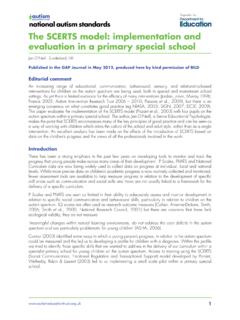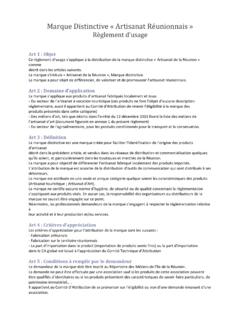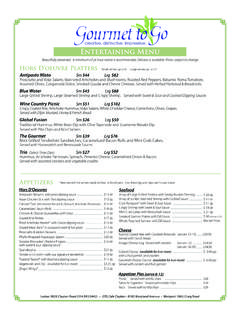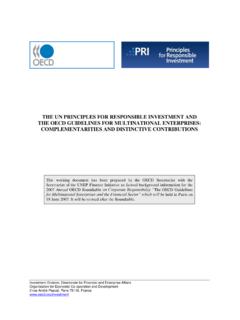Transcription of Supported by: national autism standards ard The ...
1 national autism by:1 The distinctive Clinical and Educational Needs of Children with Pathological Demand Avoidance Syndrome: Guidelines for Good Practice Phil Christie, UKTaken from the Good autism Practice Journal published by BILD, 2007, by kind permissionAddress for correspondence: Phil ChristieDirector of Children s Services,Elizabeth Newson Centre,272, Longdale Lane,Ravenshead,Nottinghamshire,NG15 9 AHAcknowledgements: Special acknowledgement should go to Elizabeth Newson for her pioneering work in this area. Thanks are also due to staff at Sutherland House School and the parents who have contributed to this commentPhil Christie is currently the Director of Children s Services within the Nottinghamshire Regional Society for Children and Adults with autism (NoRSACA) and has been Principal of a specialist school for children with autism for over 25 years.
2 This paper was first presented at the World autism Congress held in Cape Town, South Africa in 2006. It provides details on a syndrome which was identified over a long period of time by Professor Elizabeth Newson, often in work done jointly with this author, Phil Christie. In the many diagnostic assessments conducted at the Child Development Research Unit based at the University of Nottingham, she found there were children referred with a possible diagnosis of autism who did not seem typical in that they shared some of the features but had other very different behaviours and characteristics.
3 There were also more girls affected than boys. After several years of careful note-taking and interviews with parents, she felt that there was sufficient evidence to create a new syndrome or diagnostic description within the category of Pervasive Developmental Disorders. She named this Pathological Demand Avoidance syndrome and first brought it to public attention in 1980 s. Since that time, there has been much debate between professionals as to whether this is indeed a separate condition or whether the behaviours found in PDA can be explained within other disorders such as attachment disorder or personality disorder or a female form of autism .
4 Readers of this paper can send their thoughts and personal experiences to the author or the Editors of GAP to add to the term Pathological Demand Avoidance syndrome was first used during the 1980s by Professor Elizabeth Newson in a series of lectures, presentations and papers that described an evolving understanding of a group of children who had been referred for diagnostic assessment at the clinic based at the Child Development Research Unit at Nottingham University. This clinic operated as part of a centre for postgraduate national autism by:2training of clinical and educational psychologists and specialised in children who had communication and developmental difficulties.
5 By its nature as a specialist clinic, most of the children referred were complex and anomalous in their developmental profile and many reminded the referring professionals of children with autism or Asperger s syndrome. At the same time, though, they were often seen as atypical in some way. Many of these children came away from the clinic with a diagnostic assessment report which described them, in various ways, as being atypically autistic . Newson and her colleagues began to feel increasingly dissatisfied with this description, especially by the fact that it was not particularly helpful in removing the confusion that was often felt by parents and teachers who were struggling to gain greater insight into the child s behaviour.
6 Over time, Newson began to notice that while these children were atypical of the clinical picture of autism or Asperger s syndrome they were typical of each other in some very important ways. The central feature that was characteristic of all the children was an obsessional avoidance of the ordinary demands of everyday life (Newson, 1990; Newson et al, 2003). This was combined with sufficient social understanding and sociability to enable the child to be socially manipulative in their avoidance. It was this level of social understanding, along with a capacity for imaginative play, which most strongly countered a diagnosis of a series of publications, based on increasing sample sizes (up to 150 cases) and Supported by follow up studies (Newson and David, 1999), the clinical description of PDA was refined and the differences between this profile and those found in children with a diagnosis of autism or Asperger s syndrome made clearer (Newson, 1996; Newson and Le Marechal, 1998).
7 The studies also demonstrated the robustness of the clinical descriptions from childhood into adulthood. These publications culminated in a proposal (Newson et al., 2003) to recognise PDA as a separate entity within pervasive developmental disorders . This paper describes the defining criteria for a diagnosis of PDA, together with a comparison of children with autism or Asperger s syndrome through the use of a discriminant functions analysis. In this analysis a sample of 50 children with PDA were compared to two comparison groups: 20 with autism and 20 with Asperger s syndrome.
8 The most strongly discriminant features were the extent of social manipulation and excessive lability of mood in the PDA group. Children with Asperger s syndrome demonstrated more symbolic play than the children in the autism group, but significantly less than the PDA group. Another factor which discriminated the groups was the gender ratio: in the PDA group there was the same number of boys to girls compared to the typical ratios of 4 or 5 boys to 1 girl in autism and 10 boys to each girl in Asperger s proposed that the clinical description of PDA be conceptualised as a separate identity as it gives specific status to a large proportion of those children and adults who earlier might have been diagnosed as having pervasive developmental disorder not otherwise specified (PDD-NOS)
9 , a much less helpful diagnosis in terms of guidelines for for Pathological Demand Avoidance syndromeA short summary of the diagnostic criteria described by Newson is presented below, together with examples taken from clinical experience of children seen at the Child Development Passive early history in the first yearOften there are delayed milestones and the child might not reach for their toys or drops them. Child begins to become more actively resistant as more is expected; some are resistant from the start. Parents frequently report adapting so much to their child that they are unprepared for their child s later failure.
10 Early on children may be seen as puzzling in some way but not Continues to resist and avoid ordinary demands of life, with strategies of avoidance being essentially socially manipulativeThis is the criterion that designates the syndrome. Children seem under an extraordinary degree of pressure from ordinary everyday demands and expectations and attempt to avoid these to an obsessive extent. A key feature is that the child has sufficient social understanding to be socially manipulative in their endeavours national autism by:3and will often adapt strategies to the person making the demand.













